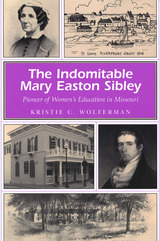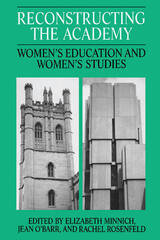3 books about Women's Education

The Indomitable Mary Easton Sibley
Pioneer of Women's Education in Missouri
Kristie C. Wolferman
University of Missouri Press, 2008
Acknowledged as a significant figure in the history of women on the early western frontier, Mary Easton Sibley may be little known to many modern readers. Yet she was involved in most of the important events in nineteenth-century Missouri, pursued and practiced educational innovations, and founded a school that continues to thrive today. This first biography of Sibley sheds new light on this important pioneer.
Kristie Wolferman retraces the course of an exciting life, beginning with four-year-old Mary’s arrival in St. Louis in 1804 when her father was appointed attorney general for the District of Louisiana—and the Eastons became one of the first American families to settle in this bustling French town. At fifteen, Mary married George Champlin Sibley, the factor of Fort Osage in Western Missouri, where the young bride lived among the Indians on the edge of the frontier and took up her teaching vocation. She then went on to found Linden Wood in St. Charles, the first college for women west of the Mississippi, and she also taught classes for African American and immigrant children. Throughout the story, Wolferman shows us a life intimately entwined with the history of the state, as Mary witnessed St. Louis in its primitive years and frontier life at Fort Osage, as well as changes in Indian policy and citizenship for former slaves.
Although Sibley’s life has been told in older accounts, Wolferman’s is the first to draw fully on Mary and George Sibley’s journals and letters, with Mary’s journal especially shedding light on her views regarding women’s social and political roles, slavery, temperance, religion, and other topics. By reconstructing Sibley’s inner life as well as her career, Wolferman depicts not merely a frontier heroine and educational pioneer but an assertive woman who did not hesitate to express unconventional views.
Today, Lindenwood University is a major coeducational institution that continues to honor Mary Sibley’s philosophy and dedication. This biography not only brings to life one of Missouri’s most remarkable women educators but also demonstrates how her story reflects educational, religious, and social developments in both the state and the nation. The Indomitable Mary Easton Sibley recognizes her as a key player on the frontier and as a major part of Missouri’s heritage.
[more]

Kinshasa in Transition
Women's Education, Employment, and Fertility
David Shapiro and B. Oleko Tambashe
University of Chicago Press, 2003
After decades of tremendous growth, Kinshasa-capital of the Democratic Republic of the Congo-is now the second-largest urban area in sub-Saharan Africa. And as the city has grown-from around 300,000 people in the mid-1950s to more than five million today-it has experienced seismic social, economic, and demographic changes.
In this book, David Shapiro and B. Oleko Tambashe trace the impact of these changes on the lives of women, and their findings add dramatically to the field's limited knowledge of African demographic trends. They find that fertility has declined significantly in Kinshasa since the 1970s, and that women's increasing access to secondary education has played a key role in this decline. Better access to education has also given women greater access to employment opportunities. And by examining the impact of such factors as economic well-being and household demographic composition on the schooling of children, Shapiro and Tambashe reveal how one generation's fertility affects the next generation's education.
This book will be a valuable guide for anyone who wants to understand the complex and ongoing social, demographic, economic, and developmental changes in contemporary sub-Saharan Africa.
In this book, David Shapiro and B. Oleko Tambashe trace the impact of these changes on the lives of women, and their findings add dramatically to the field's limited knowledge of African demographic trends. They find that fertility has declined significantly in Kinshasa since the 1970s, and that women's increasing access to secondary education has played a key role in this decline. Better access to education has also given women greater access to employment opportunities. And by examining the impact of such factors as economic well-being and household demographic composition on the schooling of children, Shapiro and Tambashe reveal how one generation's fertility affects the next generation's education.
This book will be a valuable guide for anyone who wants to understand the complex and ongoing social, demographic, economic, and developmental changes in contemporary sub-Saharan Africa.
[more]

Reconstructing the Academy
Women's Education and Women's Studies
Edited by Elizabeth Minnich, Jean F. O'Barr, and Rachel A. Rosenfeld
University of Chicago Press, 1988
READERS
Browse our collection.
PUBLISHERS
See BiblioVault's publisher services.
STUDENT SERVICES
Files for college accessibility offices.
UChicago Accessibility Resources
home | accessibility | search | about | contact us
BiblioVault ® 2001 - 2024
The University of Chicago Press









